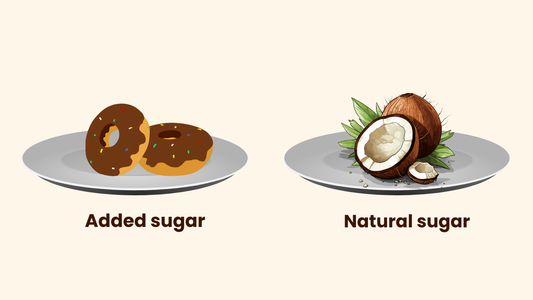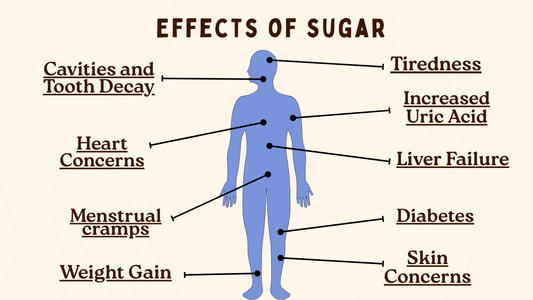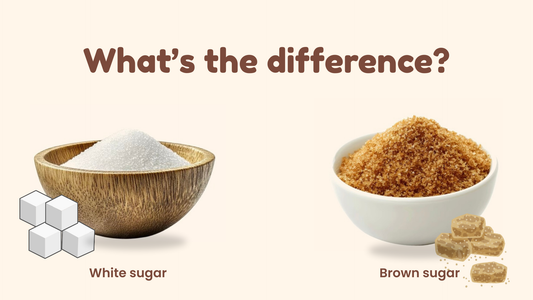The Sweet Illusion
In India, jaggery (gur) holds a special place. For centuries, it has been part of festivals, Ayurvedic remedies, and traditional recipes. Families often believe jaggery is a healthier alternative to white sugar - packed with minerals, good for digestion, and even immunity-boosting.
It feels “natural” because it comes from sugarcane juice or palm sap, not a factory refinery. Parents proudly swap sugar for jaggery in tea or sweets, convinced they’re making the better choice.
But here’s the uncomfortable truth: jaggery is still sugar. While it carries more nutrients than white sugar, its impact on your blood sugar, weight, and long-term health is nearly the same. Let’s break it down with science.
What Is Jaggery?
Jaggery is an unrefined sweetener made by:
1. Crushing sugarcane (or sometimes palm sap) to extract juice.
2. Boiling the juice until it thickens.
3. Cooling it into solid blocks or powders.
It skips the heavy refining of white sugar, so it retains some minerals like iron, magnesium, and potassium. That’s why it’s often called “medicinal” in Indian households.
Nutritional Profile of Jaggery
Per 100 grams (USDA data):
• Calories: ~383
• Carbohydrates: ~98 g
• Iron: ~11 mg (~60% daily value)
• Potassium: ~1050 mg (~20% daily value)
• Magnesium: ~160 mg (~40% daily value)
On paper, jaggery looks impressive compared to white sugar, which has no nutrients. But here’s the catch:
• Most people consume jaggery in teaspoons or tablespoons, not 100 g portions.
• A teaspoon (4 g) of jaggery provides only 0.4 mg iron - less than 2% of your daily need.
• You’d need to eat 100 g (about 25 teaspoons) to get meaningful nutrition, which equals 383 calories of sugar.
👉 In real-life servings, the nutrient advantage is tiny and irrelevant.
Calories: Same as Sugar
• White sugar: ~387 kcal per 100 g
• Jaggery: ~383 kcal per 100 g
The calorie difference? Negligible. Both are pure energy with little satiety, making them easy to overeat.
Glycemic Index and Blood Sugar Impact
This is where the “guilt-free” myth really breaks.
• White sugar GI: ~65
• Jaggery GI: ~84 (varies by source, often higher than sugar!)
A higher GI means jaggery spikes blood sugar faster and harder than sugar.
For diabetics, jaggery is actually worse than sugar. That soothing cup of “jaggery tea” could be sending blood glucose soaring.
The Myths About Jaggery
Myth 1: “Jaggery purifies blood.”
No scientific study supports this. It’s a cultural belief, not evidence-based.
Myth 2: “Jaggery is safe for diabetics.”
False. Its high glycemic index makes it dangerous for people managing blood sugar.
Myth 3: “Jaggery boosts immunity.”
While it has trace minerals, the amounts are too low to impact immunity. A fruit or vegetable provides far more nutrition.
Myth 4: “Jaggery is better for weight loss.”
Completely false. Jaggery has nearly the same calories as sugar, and often increases cravings because of its strong sweetness.
What Science Says
• Journal of Clinical & Diagnostic Research (2015): Found that jaggery consumption significantly raises blood glucose and insulin response, making it unsuitable for diabetics.
• Indian Journal of Endocrinology and Metabolism (2012): Showed that “natural” sugars like jaggery and honey have similar metabolic effects as refined sugar.
• Public Health Nutrition (2020): High GI sweeteners, regardless of nutrient content, are linked to increased risk of diabetes and metabolic syndrome.
👉 The verdict from science is clear: jaggery is nutritionally richer, but metabolically just as harmful - if not worse - than sugar.
The Bigger Problem: Overconsumption in India
In India, jaggery is often used generously:
• Chikki, laddoos, payasam, halwa
• Jaggery tea or milk daily
• “Energy booster” during winters
This adds up quickly. Many people unknowingly cross the WHO limit for added sugars (25–50 g/day) even when avoiding white sugar - simply because they think jaggery is guilt-free.
Natural Sugar vs Added Sugar: Context Matters
• Natural sugars in fruits/dairy: Come with fiber, antioxidants, slower absorption → protect against inflammation.
• Jaggery (added sugar): Still a concentrated sweetener, stripped of fiber, absorbed quickly → spikes blood sugar.
So while jaggery is “less processed,” it’s still an added sugar - and the body doesn’t treat it differently.
Healthier Alternatives: Breaking the Illusion
If your goal is sweetness without guilt, jaggery isn’t the answer. The better approach:
• Cut back on all added sugars - jaggery, sugar, honey, syrups.
• Use monk fruit sweetener for sweetness without spikes.
At EPRA Farms, we’re introducing monk fruit blends as India’s first clean-label sweetener:
• Zero calories.
• Zero glycemic impact.
• Safe for diabetics and families.
• Naturally derived from monk fruit extract + erythritol, no artificial chemicals.
That’s the real way to enjoy sweetness without falling for myths.
Final Takeaway: Jaggery’s Not the Hero You Think
• Nutrients: Yes, but in trace amounts that don’t matter in real servings.
• Calories: Same as sugar.
• Blood sugar: Spikes even faster than sugar.
• Health benefits: Largely exaggerated.
👉 Jaggery is not guilt-free. It’s just another form of sugar, wrapped in tradition and marketed as healthy.
The smarter choice is to see jaggery for what it is: a sweetener with flavor, not a medicine. For real health, focus on cutting added sugars - and finding clean, safe alternatives like monk fruit.
Previous
Does brown sugar really make a difference?
Next
The hidden link between sugar and inflammation





